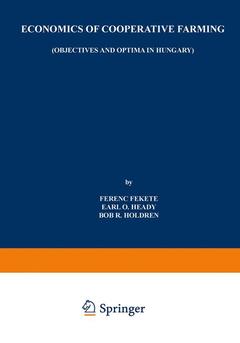Description
Economics of Cooperative Farming, 1976
Objectives and Optima in Hungary
Author: Fekete Ferenc
Language: English
Keywords
Approximative price 52.74 €
In Print (Delivery period: 15 days).
Add to cart
Publication date: 10-2013
184 p. · 17x24.4 cm · Paperback
184 p. · 17x24.4 cm · Paperback
Description
/li>Contents
/li>
The present scientific and technical revolution has brought science into the range of the most effective forces of production. The formula "science= production force" applies also to the social sciences whose explorations of human relationships and drives have reached previously unsuspected depths. Objectives, such as higher living standards and full employment, economic growth and stability, social equity and security, have both called for and provided a basis for the exploitation of possibilities offered by the natural and technical sciences. In today's agriculture, age-old traditions are in the process of disintegra tion, but the heredity of a century (or that of even a millennium as in Hungary) does not get dissolved without defending itself. Technical progress and social restratification, the emergence of new scales of values and preferences, the adjustment of the rural communities to their new tasks and conditions - all these have transformed farm operations and farming techniques. But agriculture, even under its revolutionized surface, still hides deep, almost untouched layers. If economists and agriculturalists are perplexed by the multitude and variety of the visible farm problems, there exist many others about which they can only guess, which they must follow up. In formulating and solving these problems, agricultural economists have professional tasks: (1) facilitating the most efficient use of agricultural resources from the standpoint of the national economy, and (2) helping farmers and farm people to attain their stated, socially feasible objectives.
One Transformation and Recent Organization of Hungarian Agriculture.- I. The Postwar Land Reform.- II. The Socialist Transformation of Hungarian Agriculture.- III. Scale Returns, Farm Size and Changes in Farm Organization.- IV. Changes in Hungary’s Farm Organization: A Mathematical Restatement.- Two Cooperative Models.- v. The Major Social and Economic Features of Cooperative Farming.- VI. Mathematical Models of Cooperative Farming.- Three Cooperative Optimization.- VII. Theoretical and Methodological Aspects of Cooperative Optimization.- VIII. Optimization in the Large Collective Enterprise.- IX. Economic Welfare and Objectives of Cooperative Households.- X. Cooperative Equilibrium and Economic Policy.- Summary And Conclusions.- References.
© 2024 LAVOISIER S.A.S.
These books may interest you

Family Farming In Europe And America 160.25 €



